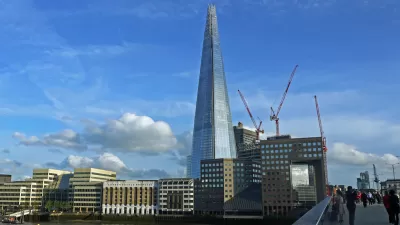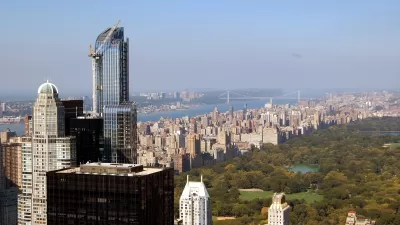What is the best height to promote good urban living? It needs to be high to attain necessary density but not so high that it detracts from the quality of life, particularly for existing residents. In short, what is the Goldilocks height level?

Are residential high rises good for the urban environment? Lloyd Alter, Toronto resident and managing editor of TreeHugger, answers that question in The Guardian's "Live Better Challenge" that focuses on sustainable living, He asserts that "(t)he trend for elite towers that reach ever skywards isn't healthy for a sustainable community or for a balanced quality of life."
There is no question that high urban densities are important, but the question is how high, and in what form. There is what I have called the Goldilocks density: dense enough to support vibrant main streets with retail and services for local needs, but not too high that people can't take the stairs in a pinch. Dense enough to support bike and transit infrastructure, but not so dense to need subways and huge underground parking garages. Dense enough to build a sense of community, but not so dense as to have everyone slip into anonymity.
In Manhattan, Alter would find many in agreement about the obtrusiveness of what they call "supertowers," reports NPR's New York City correspondent, Margot Adler [listen here], on the opposition movement to the One57 building and the shadows (see photo) it will cast over Central Park, though they have their defenders.
"The shadows cast by tall, slender buildings, which is what most of the buildings going up are, are very brief — maybe they're 10 minutes in any one place — and cause no negative effect on the flora or fauna of the park," said Gary Barnett, president of Extell Development.
Back to our Treehugger editor, Lloyd Alter, an architect, environmentalist and a "heritage activist" residing in Toronto. On his world list of supertowers, he points to the "knocking down (of) four designated heritage buildings to build three 85-storey Frank Gehry towers." While he doesn't write much about them, I suspect they may be the root of his column.
Fortunately, he includes a link to a local architectural review of the project, even if it is a flattering one, designed by the world-famous Gehry, a Toronto native. [Also see a post here on the project: "Toronto Asks Gehry to Go Back to Drawing Board."]
For a good read on Toronto density, see Planetizen exclusive: "Mid-Rise: Density at a Human Scale."
FULL STORY: Cities need Goldilocks housing density – not too high or low, but just right

Alabama: Trump Terminates Settlements for Black Communities Harmed By Raw Sewage
Trump deemed the landmark civil rights agreement “illegal DEI and environmental justice policy.”

Planetizen Federal Action Tracker
A weekly monitor of how Trump’s orders and actions are impacting planners and planning in America.

The 120 Year Old Tiny Home Villages That Sheltered San Francisco’s Earthquake Refugees
More than a century ago, San Francisco mobilized to house thousands of residents displaced by the 1906 earthquake. Could their strategy offer a model for the present?

Study: How Urban Parks Can Support Biodiversity
Conservation and recreation can go hand in hand in urban green spaces designed to serve both humans and local wildlife.

High-Speed Rail Tracker
Smart Cities Dive follows high-speed rail developments around the country

Ken Jennings Launches Transit Web Series
The Jeopardy champ wants you to ride public transit.
Urban Design for Planners 1: Software Tools
This six-course series explores essential urban design concepts using open source software and equips planners with the tools they need to participate fully in the urban design process.
Planning for Universal Design
Learn the tools for implementing Universal Design in planning regulations.
Clanton & Associates, Inc.
Jessamine County Fiscal Court
Institute for Housing and Urban Development Studies (IHS)
City of Grandview
Harvard GSD Executive Education
Toledo-Lucas County Plan Commissions
Salt Lake City
NYU Wagner Graduate School of Public Service



























